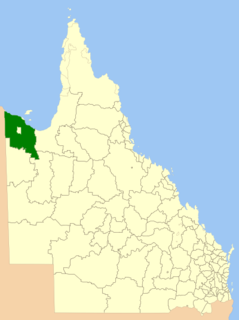Notes and references
Notes
- ↑ Kerwin 2011, p. 47.
- ↑ Trigger 2015, p. 59.
- ↑ Trigger 2015, p. 56.
- ↑ Trigger 2015, pp. 57–58.
Related Research Articles
The Bakanambia, also known as the Wanbara, are an Aboriginal group of Australia. Traditionally, the Bakanambia lived in the vicinity of Princess Charlotte Bay in the state of Queensland. One of the ethnonyms applied to them was Lama Lama, which is now used of a larger aggregation of remnants of several tribes.
Mingginda or Minkin is an extinct Australian Aboriginal language, perhaps a language isolate, of northern Australia. It was spoken by the Mingin people in the area around Burketown, on the southern coast of the Gulf of Carpentaria, in an area that contains the headwaters of the Leichhardt River.
The Wik peoples are an Indigenous Australian group of people from an extensive zone on western Cape York Peninsula in northern Queensland, speaking several different languages. They are from the coastal flood plains bounding the Gulf of Carpentaria lying between Pormpuraaw and Weipa, and inland the forested country drained by the Archer, Kendall and Holroyd rivers. The first ethnographic study of the Wik people was undertaken by the Queensland born anthropologist Ursula McConnel. Her fieldwork focused on groups gathered into the Archer River Mission at what is now known as Aurukun.

The Shire of Burke is a local government area in North West Queensland, Australia. The shire lies on the south coast of the Gulf of Carpentaria and abuts the border with the Northern Territory. It covers an area of 39,864 square kilometres (15,391.6 sq mi), and has existed as a local government entity since 1885. The major town and administrative centre of the shire is Burketown. The shire and town and the Burke River passing through all are named in honour of ill-fated explorer Robert O'Hara Burke.

The Aboriginal Shire of Doomadgee is a special local government area in North West Queensland, Queensland, Australia. It is managed under a Deed of Grant in Trust under the Local Government Act 2004.

The Gulf Country is the region of woodland and savanna grassland surrounding the Gulf of Carpentaria in north western Queensland and eastern Northern Territory on the north coast of Australia. The region is also called the Gulf Savannah. It contains large reserves of zinc, lead and silver. The Gulf Country is crossed by the Savannah Way highway.

The Nicholson River is a river located in the Northern Territory and the state of Queensland, Australia.
The Lardil are an indigenous Australian people and the traditional owners of Mornington Island in the Wellesley Islands chain in the Gulf of Carpentaria, Queensland.
The Nguburinji, also written Ngoborindi, were an Indigenous Australian people who traditionally lived in northwest Queensland south of the Ganggalida, north of the Injilarija, west of the Mingin and east of the Waanyi.
The Waanyi people, also spelt Wanyi, Wanji, or Waanji, are an Aboriginal Australian people from south of the Gulf of Carpentaria in Queensland and the Northern Territory.
The Injilarija people were an Indigenous Australian people south of the Gulf of Carpentaria in Queensland who lived east of the Waanyi, south of the Nguburinji and west of the Mingginda that are considered extinct.
The Garrwa people, also known as Garawa, are an Indigenous Australian people living in the Northern Territory whose traditional lands extended from east of the McArthur River at Borroloola to Doomadgee and the Nicholson River in Queensland.
The Yanyuwa people are an Indigenous Australian people of the Northern Territory who live in the coastal region inclusive of and opposite to the Sir Edward Pellew Group of Islands in the southern Gulf of Carpentaria.
The Warndarang (waɳʈaraŋ) were a predominantly coastal Aboriginal Australian people of eastern Northern Territory. Though extinct as a distinct ethnolinguistic group, their descendants survive among the neighbouring Nunggubuyu.
The Ngalakgan are an indigenous Australian people of the Northern Territory.
The Kungarakan (Koongurrukuñ) were an indigenous Australian people of the Northern Territory.
The Mingin, also known as the Mingginda, were an indigenous Australian people of the state of Queensland, who lived in the Gulf Country east of Moonlight Creek and the Ganggalida people in the southern Gulf of Carpentaria. They are now thought to be extinct.
The Djerait were an indigenous Australian people of the Northern Territory
The Pongaponga were an indigenous Australian people of the Northern Territory. They may have been a band of the Ngolokwangga.
The Wadere were an indigenous Australian people of the Northern Territory.
References
- Kerwin, Dale (2011). Aboriginal Dreaming Paths and Trading Routes: The Colonisation of the Australian Economic Landscape. Sussex Academic Press. ISBN 978-1-845-19529-8.CS1 maint: ref=harv (link)
- Trigger, David (2015). "Change and Succession in Aboriginal Claims to Land". In Toner, P.G. (ed.). Strings of Connectedness: Essays in honour of Ian Keen. Australian National University Press. pp. 53–73. ISBN 978-1-925-02263-6.CS1 maint: ref=harv (link)